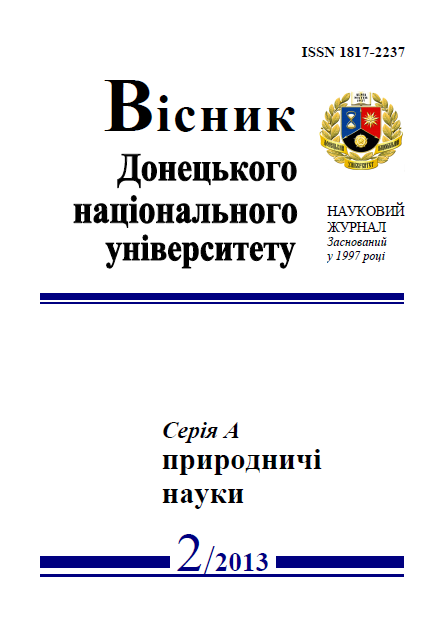Synthesis and surface morphology of Europium and Lutetium heteropoly hexatungstonickelate (II)
Keywords:
heteropoly, heteropolyanion, Anderson structure, europium, lutetium, electron microscopyAbstract
The conditions for europium and lutetium heteropoly hexatungstonickelate (II) Ln4[Ni(OH)6W6O18]3·nH2O (Ln = Eu, Lu) synthesis by direct reaction in the system Ni2+ – WO4 2- – H+ – H2O (ν(Ni2+) : ν(WO4 2–) : ν(H+ ) = 1 : 6 : 6), and by an exchange reaction from Na4[Ni(OH)6W6O18]·16H2O were elaborated. By FTIR spectroscopy showed that the anions in the isolated salts corresponds to the Anderson structure [Ni(OH)6W6O18] 4–. The surface morphology of obtained salts was investigated by scanning electron microscopy. It was found that the way of obtaining is influence on the grain size – 100 –250 nm in the case of the direct reaction, and 200–400 nm in the case of the exchange reaction. Homogeneity of the obtained phase was confirmed by the uniform contrast of the surface mode of backscattered electrons.
References
A novel polyoxometalate chain formed from heteropolyanion building blocks and rare earth metal ion linkers: [La(H2O)7Al(OH)6Mo6O18]n·4nH2O / V. Shivaiah, P.V.N. Reddy, L.Cronin [et al.] // J. Chem. Soc., Dalton Trans. – 2002. – P. 3781-3782.
Influence of different site symmetries of Eu3+ centers on the luminescence properties of Anderson-based compounds / R. Cao, S. Liu, L. Xie [et al.] // Inorganica Chimica Acta. – 2008. – Vol. 361. – P. 2013-2018.
Drewes D. Synthesis and structure of a novel type of polyoxomolybdate lanthanide complex: [(Ln(H2O)6)2(TeMo6O24)] (Ln = Ho, Yb) / D. Drewes, B. Krebs // Z. Anorg. Allg. Chem. – 2005. – Vol. 631. – P. 2591-2594.
Self-Assembly of polyoxometalate-supported ln-h nydroxo/oxo clusters with 1d extended structure: [LnIII(H2O)7Cr(OH)6Mo6O18]n·4nH2O (Ln = Ce, Sm, Eu) / D.-M. Shia, F.-X. Mab, C.-J. Zhanga [et al.] // Z. Anorg. Allg. Chem. – 2008. – Vol. 634. – P. 758-763.
Фазообразование в системе Ni2+–WO4 2––H+ –H2O (Z = 1,00). Кристаллическая структура и свойства гетерополигексавольфрамоникелата (+2) натрия Na4[Ni(OH)6W6O18]·16H2O / Г.М. Розанцев, С.В. Радио, Н.И. Гумерова [и др.] // Журнал структурной химии. – 2009. – Т. 50, № 2. – С. 311-319.
Шарло Г. Методы аналитической химии. Количественный анализ неорганических соединений / Г. Шарло. – Л: Химия, 1965. – 975 c.
Коростелев П.П. Приготовление растворов для химико-аналитических работ / П.П. Коростелев. – М: Наука, 1964. – 400 c.
Практическое руководство по неорганическому анализу / В.Ф. Гиллебранд, Г.Э. Лендель, Г.А. Брайт, Д.И. Гофман. – М: Химия, 1966. – 1112 с.
Радио С.В. Моделирование равновесий в растворах Ni2+ – WO4 2– – Н+ – Н2О / С.В. Радио, Ф.Н. Павлий, Г.М. Розанцев // Вопр. химии и хим. технологии. – 2009. – № 4. – С. 152-158.
Lee U. Tetraammonium hexahydrogen hexamolybdonickelate (II) tetrahydrate, (NH4)4[H6NiMo6O24]·4H2O / U. Lee, H.-C. Joo, J.-S. Kwon // Acta Cryst. Sec. E. – 2002. – Vol. E58. – C. i6-i8.

